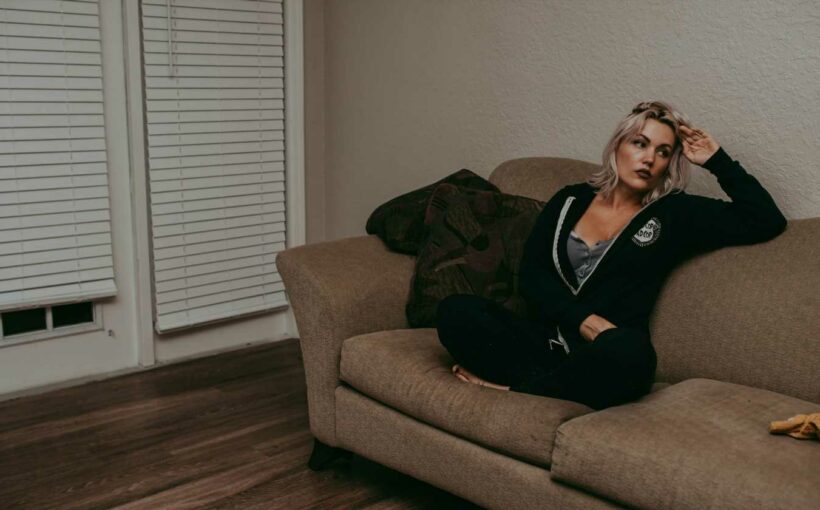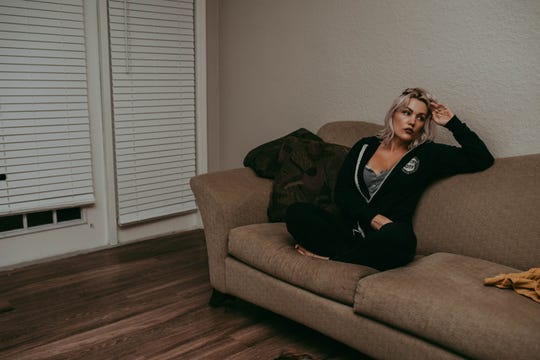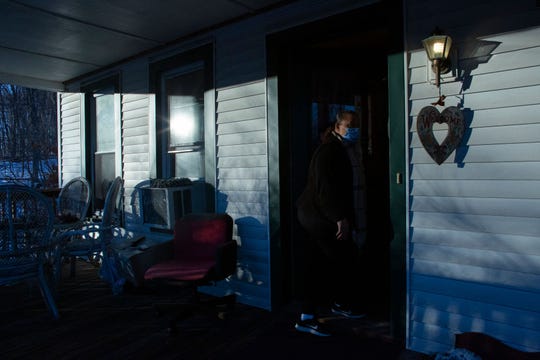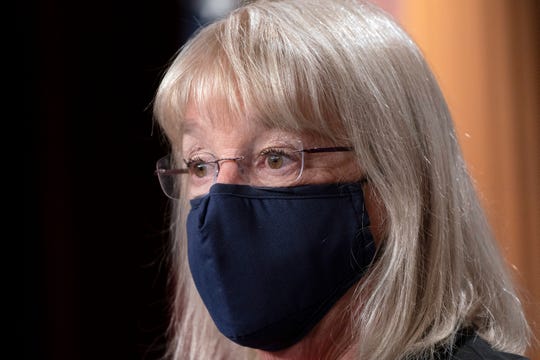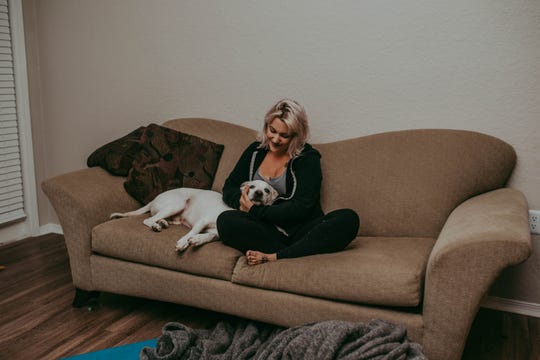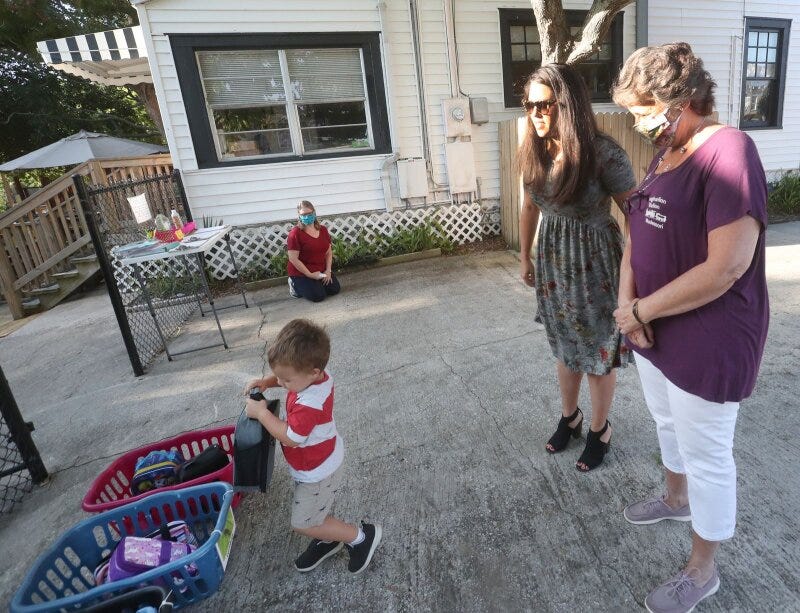This time, Lindsay McAndrew was running away for good. After a decade of suffering domestic violence, the COVID-19 pandemic made her realize she needed a clean break.
McAndrew, 35, grabbed birth certificates, Social Security cards and $1,700 cash from her children’s piggy banks. She packed the minivan with the three kids and family dog, Charlie. As she pulled out of the driveway in Orlando, Florida, in September, she headed to the only safe haven she knew—her mom’s house in New Jersey.
“I felt like I was screaming, but nobody could hear me,” said McAndrew.
Now, months after McAndrew’s divorce was finalized, the newly single mom is facing other challenges as the family’s sole breadwinner: a vicious custody battle that required her to move back to Florida under court orders and find child care so she can work to pay rent and other bills.
Against a backdrop of increasing domestic violence across the country, federal assistance could make a life-changing difference for many families living through a pandemic that has heightened mental health, child care and economic challenges, experts said.
The Senate approved Saturday a $1.9 trillion stimulus that includes $24 billion to stabilize the child care industry, $15 billion for child care subsidies and $450 million for domestic violence services. The legislation now returns to the House, where it is expected to be passed and sent to President Joe Biden for final approval.
For McAndrew, a child care subsidy is crucial to becoming financially independent.
“If there was universal child care or something guaranteed, I could devote time and energy to my career and provide for my kids instead of constantly juggling 10,000 things,” she said.
Lindsay McAndrew poses for a picture on March 5, 2021. (Photo: Lindsay McAndrew)
Leaving a domestic violence situation is always difficult for the victim because they lack resources, support and it can be dangerous, experts said.But the pandemic has compounded these challenges with shelter-in-place orders and the economic recession.
COVID-19 has resulted in the disappearance of 4.5 million child care slots across the United States because of social distancing and lockdowns, according to The Center for American Progress.
Women who spoke to USA TODAY from undisclosed shelters and locations said they couldn’t leave their children alone to look for a job. For those that got offers, there simply aren’t options to have their kids looked after while they work.
More than 10 million women and men experience intimate partner violence a year, according to the National Coalition Against Domestic Violence based in Colorado.The National Domestic Violence Hotline reported a 9% uptick in emergency calls during the months of March through May when many states issued lockdown orders. Police departments have reported increases ofdomestic violence cases around the country including 18% in San Antonio, 22% in Portland and 10% in New York City, according to the American Journal of Emergency Medicine.
Experts said child care is important to breaking the economic cycle of violence.
“If you don’t have the ability to drop off your kid, then you don’t have the ability to work,” said Luana Marques, a professor of psychology at Harvard Medical School in Cambridge, Massachusetts, and president of the Anxiety and Depression Association of America.
Cheryl Bullock-Hannah, volunteer, opens the door of the shelter "Strengthen Our Sisters" in Paterson, New Jersey on February 25, 2021. (Photo: KENA BETANCUR, AFP via Getty Images)
COVID-19 relief bill could be a turning point for child care
A key provision of the stimulus bill centers on the $15 billion that expands funding for states to provide child care subsidies for low-income families with children 13 or younger—including domestic violence survivors.
The Center on Budget and Policy Priorities, a think tank that analyzes federal and state government budget policies, found that child care already consumed a large part of poor families’ budgets prior to the onset of COVID-19. For households with incomes below the federal poverty level of $26,500 for a family of four, child care averages 30% of their income.
In addition to emergency funds for child care and domestic violence support services, Congress’ proposed relief package also includes a historic expansion of the child tax credit, $160 billion earmarked for school re-openings and $1,400 stimulus checks for Americanswho earn less than $75,000 a year.
U.S. Sen. Patty Murray, chair of the Senate Committee on Health, Education, Labor, and Pensions, said this relief is key at a time where hundreds of thousands of women, especially those of color, are being driven out of the workforce and survivors face increased barriers to safety. Murray introduced in May the Child Care is Essential Act, which would cover operating expenses for child care centers, require providers pay their staff and tuition assistance for working families.
U.S. Sen. Patty Murray, chair of the Senate Committee on Health, Education, Labor, and Pensions, speaks to the media on March 2, 2021. Murray introduced the Child Care is Essential Act in May, saying child care assistance is needed at a time where thousands of women, especially those of color, are being driven out of the workforce. (Photo: Jacquelyn Martin, AP)
“It is heartbreaking—and absolutely unacceptable—that not being able to find or afford child care is the reason some women are unable to leave an abuser,” Murray told USA TODAY. “We need to fix this.”
She added: “Women need to be able to get the support services they need, to be able to get their own paycheck to protect themselves against economic abuse and to know that their child is safe.”
Child care costs on average $9,000 annually per child.
“A year of child care is roughly the same cost as a year at the University of Minnesota,” said U.S. Sen. Tina Smith, a Democrat from Minnesota who co-sponsored the bill, during a call with reporters to discuss the stimulus plan.
While advocates acknowledge this child care relief is long-overdue, many say it falls short of the need and does little to address the systemic gaps for women of color. Wendoly Marte, of Community Change Action in Washington D.C., said Congress needs to invest an additional $100 billion longterm to stabilize the child care industry, which is made up of many day care workers who are women of color, and expand access to subsidies for low-income mothers of color.
It is critical those dollars “go to low income, working-class, Black, Indigenous, women of color who have the least access to resources and support, to get on their feet, heal and rebuild their lives,” said Cat Brooks, executive director at the Justice Teams Network, an anti-violence organization based in Oakland, California.
Artwork made by the residents is displayed at the shelter "Strengthen Our Sisters," a timber farm-turned shelter for women who have suffered domestic violence in Paterson, N.J., on Feb. 25, 2021. (Photo: KENA BETANCUR, AFP via Getty Images)
COVID-19 made it harder for survivors to seek out help
After years of what she described as domestic abuse,McAndrew thought the nightmare would be over as soon as she left and her ex-husband was served with divorce papers.
“I felt like he had broken my spirit. I had no fight left in me,” she said with a cracked voice.
He agreed to the divorce but sued her for custody. McAndrew was ordered by a judge to return to the marital home with her kids to live under the same roof despite the alleged history of domestic abuse and sexual assault. She would only be able to move the kids from the house once she secured permanent housing.
“I couldn’t believe what I was hearing. My whole body was shaking, I was terrified about what he would do to me,” said McAndrew. “I left the kids with him but couldn’t bear to stay.”
Lindsay McAndrew poses for a picture on March 5, 2021. (Photo: Lindsay McAndrew)
She used points to sleep at a hotel around the corner and called shelters and domestic violence safe houses to see if they could help to no avail. McAndrew’s dad, who recently retired, used his savings to give her $1,575 toward renting a small apartment. It was the only way the court would allow her to take her kids. She also found a job that pays $20 an hour—above the $7.25 per hour minimum-wage jobs most commonly available to recent survivors.
But after she pays the rent, the remaining $900 isn’t enough to pay for groceries, health insurance and child care.
“I trade haircuts for babysitting, I beg other moms to take turns, which is dangerous because we’re in a pandemic,” she said.
Distancing protocols and safety around COVID-19 have negatively impacted people’s ability to escape to friends or family or get access to care, said Dr. Megan Evans, an obstetrician and gynecologist at Tufts Medical Center in Boston who works with women experiencing intimate partner violence.
Evans said the most vulnerable patients aren’t coming in for appointments or logging on for telehealth check-ins, which has limited the ability of physicians to refer people for services.
Most often those experiencing intimate partner violence will seek help at schools, day cares, faith-based community organizations like churches or through their physician. Many parents who are in this situation will routinely flee the home while children are at school, picking them up and moving to the new location. But making sure they have safe child care is always a priority, experts said.
Jeara McQuay (center) said she and her four children fled an abusive relationship last year. Although she has found supportive housing, she can't find adequate child care, making it impossible to find a job that allows her to support her family. (Photo: Courtesy: Jeara McQuay)
Child care is essential to breaking cycle of violence
It’s been a year since Jeara McQuay, a 42-year-old mother of four, left her abuser in Fort Collins, Colorado, she said. Her divorce was finalized on Feb. 17 and she was granted full custody.
In many ways, she’s succeeding; she recently moved out of a shelter into a subsidized apartment, she’s enrolled in school at Western Nebraska Community College, completing courses online to get an associate’s degree in criminal justice, and her children are safe.
But she can’t find adequate child care for her kids ages 5 to 12, making it impossible to find a job that allows her to support her family. She’s gotten offers to work evening and weekend shifts in retail and grocery stores for $13 an hour, a few cents over Colorado’s minimum wageand a salary that wouldn’t cover her expenses.
The thought of leaving her children alone when her ex-husband knows their address frightens her. McQuay, who said she suffers from PTSD from years of physical abuse, said she’s lucky if she gets three hours of sleep at night worrying if lack of child care will drive her into homelessness.
“I’ve climbed mountains this year and finally stayed out of the relationship,” said McQuay. “Something as simple as(the cost of) day care can just wipe everything out,” said McQuay in tears.
Margo Lindauer, director of the Domestic Violence Institute at Northeastern University School of Law in Boston, said survivors can often feel helpless because economic disenfranchisement and disrupting “a victim’s professional trajectory is a key hallmark of domestic violence.” This only worsens in a global pandemic, Lindauer said.
“It’s layer upon layer upon layer of barriers to effectively leaving and being self-sustaining,” said Lindauer, who has seen a 300% increase in referrals to her clinic, many of whom are already living in poverty and can only access low-wage service jobs working in restaurants, cleaning and—caring for other people’s children.
Sasha Staton talks with Kim Vukelja, owner and director of the Imagination Station child care center, while Nash Staton, 3, puts his lunchbox in his class's basket. Many women, including domestic abuse survivors, are struggling to pay for child care during the COVID-19 pandemic. (Photo: David Tucker/Daytona Beach News-Journal)
“How are they supposed to effectively get help? Meet that help? Plan for that help,” said Lindauer, adding that legislative efforts that expand access to safe, quality child care is one of the best ways to break the cycle of abuse.
Meanwhile, McQuay is anxiously waiting to see if the Senate will pass the new pandemic relief bill.
“It’s not that I’m not trying, it’s just that I don’t have options,” said McQuay. “I don’t want to fail this early into being on my own.”
Follow Romina Ruiz-Goiriena on Twitter: @RominaAdi
Domestic violence resources: How you can get help
If you are a victim of domestic violence, The National Domestic Violence Hotline allows you to speak confidentially with trained advocates online or by the phone, which they recommend for those who think their online activity is being monitored by their abuser (800-799-7233). They can help survivors develop a plan to achieve safety for themselves and their children.
Source: Read Full Article
